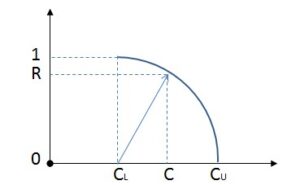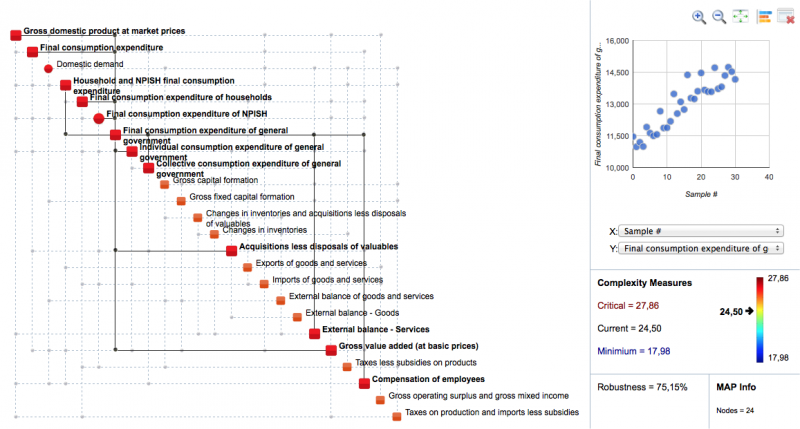Criteria
Resilience is a physical quantity which can be measured and it reflects the capacity of a system to withstand impacts, shocks and extreme events. Resilience may be measured for all systems or artifacts, such as corporations, asset portfolios, markets or national economies. The computation of resilience is based on the concept and measure of complexity. Complexity is a fundamental physical characteristic of every system that may be found in Nature and quantifies the amount of structured information the system contains. It is measured in bits. High complexity implies high functionality but also an increase of management effort and energy. When taken to extremes, excessive complexity becomes a formidable source of exposure. This is because excessively complex systems are inherently fragile. In fact, every system possesses the so-called critical complexity, in the proximity of which its behaviour is dominated by uncertainty and chaos, making it difficult to comprehend its functioning, to make forecasts and to govern it.
Resilience is independent of performance. A corporation may be profitable but, at the same time, it may lack resilience. This is because it may be highly complex, inducing concentrations of fragility which, in large organizations or systems, may be hidden or invisible for prolonged periods of time. For this reason, countries or corporations which enjoy a good credit rating may still have low a resilience rating. Resilience may also be regarded, to a certain degree, as a reflection of a system’s overall stability.[1]Ontonix S.r.l. and RateABusiness. Retrieved 2013-07-15. [2]J. Marczyk, “A New Theory of Risk and Rating” (ASIN B004CLYICO). Retrieved 2013-07-15.
Calculations
The complexity of a system having state vector {x} of N components, is defined as a function of Structure and Entropy.
C = f(S ○ E)
where S represents an N × N adjacency matrix, E is an N × N entropy matrix, ○ is the Hadamard matrix product operator and f is a norm operator. Given that S has no units and entropy is measured in bits the units of C are also bits. Once the entropy matrix and the adjacency matrix have been obtained, one may compute the complexity of a given system as the following matrix norm:
C = ║S ○ E║
A fundamental property of systems related to complexity is the so-called critical complexity, CU which corresponds to the upper bound of the complexity metric. Critical complexity may be defined formally using the above expression,
CU = ║S ○ Emax║
where Emax is the “saturated” entropy matrix. In a similar fashion, the lower bound of complexity, CL, may be computed as CL = ║S ○ Emin║.
In proximity of the lower complexity bound, the system in question is almost totally deprived of elements of uncertainty and functions in a deterministic structure-dominated fashion (imagine, for example, a watch movement). In proximity of the upper complexity bound the system in question is uncertainty-dominated and relationships between the various state vector entries are fuzzy and therefore characterized by very low generalized correlations.
At this point the measure the resilience of a system may be defined as follows
R = f(CL; C; CU)
where CL, C and CU represent, respectively, the lower complexity bound, the current system complexity and the upper complexity bound. The function f in the above equation is a second-order polynomial function such that:
if C = CL → R = 1 if C = CU → R = 0
The function is illustrated below.

A second order function has been chosen so as to penalize strongly situations in which complexity is close to critical complexity. The choice has been dictated by the fact that when a system finds itself in proximity of its critical complexity the following facts may be observed:
- Most relationships (correlations) between the state vector entries are close to “saturation”. This means that they are fuzzy and weak. Information transmission becomes unreliable.
- A small increase in entropy (uncertainty) can cause these relationships to actually vanish.
- Managing a system in which the variables are linked via fuzzy and weak relationships is generally risky.
- Systems close to criticality cannot grow unless drastic measures are taken (e.g. spin-off, restructuring, merger, massive entropy dumping, etc.).
- Once the point of criticality is passed, the system continues to decay and loses functionality. For a closed system the process is irreversible.
- Close to criticality, no single variable may be expected to govern the behaviour of the system.
Resilience rating stratification is operated on five levels: Very Low, Low, Medium, High and Very High as follows:
- Business resilience is very low. Business structure is weak. It is unsustainable and very fragile. Exposure is very high and the business is inefficient and difficult to manage. It is impossible to make forecasts. The business is a candidate for default. Resilience: 0-50%
- Business resilience is low. The business is difficult to manage and control. Exposure is high as well as inefficiency. The structure of the business is fragile hence vulnerable. It is difficult to make forecasts. Resilience: 50%-70%
- Business resilience is medium. The structure of the business is fairly robust. Performance predictability is acceptable. Exposure is moderate. Resilience: 70%-80%
- Business resilience is high. This indicates a robust business structure. Predictability is high, exposure is low. Business sustainability and efficiency are quite high. Resilience: 80%-90%
- Business resilience is very high. This business structure is very strong. Exposure is very low. The business is manageable and it is possible to make credible forecasts. The business is potentially highly sustainable and efficient. Resilience: 90%-100%
The above stratification applies to corporations, markets, portfolios or national economies or systems thereof.
Example
Resilience of Austria (2013-Q1)[3]Screenshot of Rate a Business (powered by Ontonix): Resilience of Austria (2013-Q1)

More examples of Business Structure Maps (known also as Complexity Maps) of EU countries can be found on RateABusiness.
Data source: Eurostat
Lists
References[+]
| ↑1 | Ontonix S.r.l. and RateABusiness. Retrieved 2013-07-15. |
|---|---|
| ↑2 | J. Marczyk, “A New Theory of Risk and Rating” (ASIN B004CLYICO). Retrieved 2013-07-15. |
| ↑3 | Screenshot of Rate a Business (powered by Ontonix): Resilience of Austria (2013-Q1) |